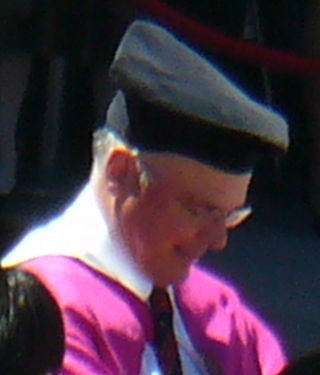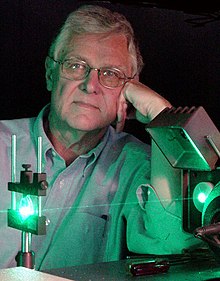This is a list of acronyms and other initialisms used in laser physics and laser applications.
William Ralph Bennett Jr. was an American physicist known for his pioneering work on gas lasers. He spent most of his career on the faculty of Yale University.
Joseph Wilfred Goodman is an engineer and physicist.
Elsa M. Garmire, Elsa Meints Garmire, was born in Buffalo, New York, on November 9, 1939. She is the Sydney E. Junkins Professor of Engineering at Dartmouth College, where she has served as Dean of Thayer School of Engineering. Elected to the American Academy of Arts and Sciences, the National Academy of Engineers, and the National Academy of Inventors, she helped pioneer laser technology and is an expert in nonlinear optics. She has patented devices to enhance optical communications including lasers, waveguides, and detectors.

Robert Louis Byer is a physicist. He was president of the Optical Society of America in 1994 and of the American Physical Society in 2012.
Anthony J. DeMaria is an American researcher in lasers and their applications, particularly known for his work with picosecond laser pulses.
Rod C. Alferness was president of The Optical Society in 2008.
Eric Van Stryland was president of the Optical Society of America in 2005.

Anthony Michael Johnson is an American experimental physicist, a professor of physics, and a professor of computer science and electrical engineering at the University of Maryland, Baltimore County (UMBC). He is the director of the Center for Advanced Studies in Photonics Research (CASPR), also situated on campus at UMBC. Since his election to the 2002 term as president of the Optical Society, formerly the Optical Society of America, Johnson has the distinction of being the first and only African-American president to date. Johnson's research interests include the ultrafast photophysics and nonlinear optical properties of bulk, nanostructured, and quantum well semiconductor structures, ultrashort pulse propagation in fibers and high-speed lightwave systems. His research has helped to better understand processes that occur in ultrafast time frames of 1 quadrillionth of a second. Ultrashort pulses of light have been used to address technical and logistical challenges in medicine, telecommunications, homeland security, and have many other applications that enhance contemporary life.
Anthony E. Siegman was an electrical engineer and educator at Stanford University who investigated and taught about masers and lasers. Known to almost all as Tony Siegman, he was president of the Optical Society of America [now Optica (society)] in 1999 and was awarded the Esther Hoffman Beller Medal in 2009.
An optical modulator is an optical device which is used to modulate a beam of light with a perturbation device. It is a kind of transmitter to convert information to optical binary signal through optical fiber or transmission medium of optical frequency in fiber optic communication. There are several methods to manipulate this device depending on the parameter of a light beam like amplitude modulator (majority), phase modulator, polarization modulator etc. The easiest way to obtain modulation is modulation of intensity of a light by the current driving the light source. This sort of modulation is called direct modulation, as opposed to the external modulation performed by a light modulator. For this reason, light modulators are called external light modulators. According to manipulation of the properties of material modulators are divided into two groups, absorptive modulators and refractive modulators. Absorption coefficient can be manipulated by Franz-Keldysh effect, Quantum-Confined Stark Effect, excitonic absorption, or changes of free carrier concentration. Usually, if several such effects appear together, the modulator is called electro-absorptive modulator. Refractive modulators most often make use of electro-optic effect, other modulators are made with acousto-optic effect, magneto-optic effect such as Faraday and Cotton-Mouton effects. The other case of modulators is spatial light modulator (SLM) which is modified two dimensional distribution of amplitude & phase of an optical wave.

Amnon Yariv is an Israeli-American professor of applied physics and electrical engineering at Caltech, known for innovations in optoelectronics. Yariv obtained his B.S., M.S. and PhD. in electrical engineering from University of California, Berkeley in 1954, 1956 and 1958, respectively.
Ali Hajimiri is an academic, entrepreneur, and inventor in various fields of engineering, including electrical engineering and biomedical engineering. He is the Bren Professor of Electrical Engineering and Medical Engineering at the California Institute of Technology (Caltech).
William W. Simmons is an American physicist at TRW and Lawrence Livermore National Laboratory (LLNL), notable for his development of electro-optical devices.

David A. B. Miller is the W. M. Keck Foundation Professor of Electrical Engineering at Stanford University, where he is also a Professor of Applied Physics by courtesy. His research interests include the use of optics in switching, interconnection, communications, computing, and sensing systems, physics and applications of quantum well optics and optoelectronics, and fundamental features and limits for optics and nanophotonics in communications and information processing.
Shun Lien Chuang was a Taiwanese-American electrical engineer, optical engineer, and physicist. He was a Fellow of the IEEE, OSA, APS and JSPS, and professor at the University of Illinois at Urbana-Champaign.

Kerry J. Vahala is an American professor of Applied Physics at the California Institute of Technology (Caltech). He holds the Ted and Ginger Jenkins chair of Information Science and Technology and also serves as the Executive Officer of the Department of Applied Physics and Materials Science. He received his B.S. and Ph.D. degrees in Applied Physics and an M.S. degree in Electrical Engineering, all from Caltech.
Cindy A. Regal is an American experimental physicist most noted for her work in quantum optics; atomic, molecular, and optical physics (AMO); and cavity optomechanics. Regal is an associate professor in the Department of Physics at the University of Colorado and JILA Fellow; and a Fellow of the American Physical Society (APS).

John E. Bowers is an American physicist, engineer, researcher and educator. He is the Fred Kavli Chair in Nanotechnology, the director of the Institute for Energy Efficiency and a distinguished professor in the Departments of Electrical and Computer Engineering and Materials at University of California, Santa Barbara. He was the deputy director of American Institute of Manufacturing of Integrated Photonics from 2015 to 2022.
Joyce Poon is Professor of Electrical and Computer Engineering at the University of Toronto and Director of the Max Planck Institute of Microstructure Physics, where her research focuses on developing new optical devices for applications in neurotechnology. She is also an honorary professor at the Technical University of Berlin. She is a Fellow of Optica, and has been serving as a Director-At-Large for the society since January 2021.






